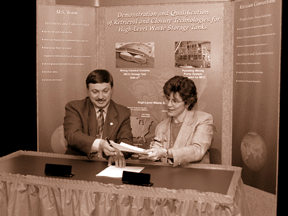Labs group will work with counterparts in Zheleznogorsk, formerly Krasnoyarsk-26
A group of Sandia researchers will head for the Central Siberian city of Zheleznogorsk soon to expand a cooperative program with Russian counterparts in developing technology to clean up waste left by decades of plutonium production.
Both the US and Russia face that daunting Cold War legacy task, and a group from the closed city Zheleznogorsk — known formerly as Krasnoyarsk-26 — visited Sandia earlier this month for briefings on US cleanup technologies and to sign the cooperation agreement.

Bob Huelskamp (5353), who heads the Sandia project team, says the Tank Retrieval and Closure Demonstration Center presents a double advantage. “The US gains access to unique Russian high-level radioactive waste remediation technologies, and Russia gets US funding to convert former weapons facilities to non-defense work employing scientists and engineers who otherwise would be challenged to find professionally and financially rewarding work,” he says.
And the financial aspect of the program also benefits the US, says Jim Lee (15331), a member of the Sandia team who has visited the Russian site several times already.
“One of the reasons we’re so excited about it is that we believe the Russian technologies will save us as much as $2 billion in the cleanup of our own complex,” he says.
The March 7 agreement was signed by Sandia and the Mining and Chemical Combine, representing, respectively, the Department of Energy and Russia’s Ministry for Atomic Energy. It is part of DOE’s Nuclear Cities Initiative and will be funded by the Department’s Initiatives for Proliferation Prevention.
The Nuclear Cities Initiative helps Moscow provide non-defense employment to weapons scientists in the 10 closed Russian nuclear cities, making it possible for them to remain in their homeland and work on civilian and commercial projects as facilities in Russia’s weapons complex are downsized or eliminated.
The center will serve as an international site where advanced equipment and technologies for remediation of high-level radioactive waste tanks can be tested before being certified for use in cleanup of both the Russian and US complexes.
“This is an exciting collaboration offering the potential to reduce future clean-up costs at US and Russian facilities by billions of dollars,” said Acting Deputy Administrator for Defense Nuclear Nonproliferation Rose Gottemoeller. “In addition, this activity puts Russia’s top scientists to work in their homeland, helping to prevent ‘brain drain,’ a major US priority.”
Senior VP Roger Hagengruber (5000) also cites the need to help convert Russia’s defense facilities to non-defense work.
“The US government’s major objective is to get an end to the Cold War in terms of production of materials that can be used for bombs,” says Roger. “The goal is to avoid proliferation of nuclear weapons worldwide by converting Russian facilities to peaceful, non-defense purposes. And in the process, we need to try to do that at the lowest possible cost to US taxpayers and with the greatest respect to Russia.”
Another DOE goal is that its $1.5 million funding for the center will help make it a world source of technology for cleaning and re- mediating high-level radioactive waste storage tanks, a $24-billion industry in the US and Russia.
“It’s important to remember,” says Roger, “that the hand that reaches out with the sword can just as easily reach out in peace. And the challenge of leadership today is doing that — laying aside the sword and reaching out in peace. That’s what these labs are trying to do, both in the United States and Russia.”
Last modified: March 24, 2000